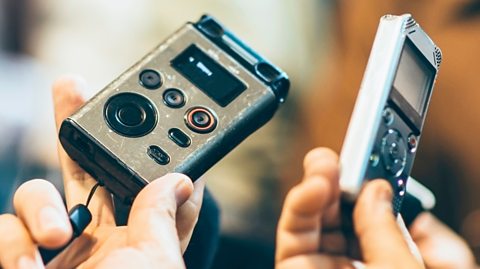Writing a radio package
A radio package is a pre-recorded report which features interviews and sound effects. Like any news report, it should cover the most important elements of a story.
A well-written package will grab the listener's attention and tell the story in an entertaining and creative way. A news package is usually about two minutes long.
To create a radio package, follow these steps:
Research the story

There are many different ways to research a story
First, research the story and find out its key points. This will help you decide what actualityAudio material recorded on location; in news programmes it is usually someone speaking and lasts for 10 to 20 seconds., interviews and sound effects you need to record. You should plan a rough outline of your report.
Get interviews

Make sure you have the right equipment to record an interview
You will need to have some good interviews and/or vox popThe views of members of the public on a specific story or issue; to record them, a journalist will usually approach people in the street or other public place and ask them the same question. to help tell the story.
Interviews
When preparing to interview someone, ensure your questions are focused on the 5 Ws and one H â that is: Who? What? Where? When? Why? and How?
During the interview, listen carefully to the answers and if you're not satisfied, follow up with extra questions.
Sometimes, an interviewee may say something unexpected which will lead to a new line of questioning or produce an interesting angle on the story - so be sure to listen at all times to what is being said.
Always record your interviewees' names and how to pronounce them.
Vox pops
Vox pops are the views of members of the public on a specific story or issue. People are usually approached by a journalist in the street or another public place, and the same questions are asked to each of them.
It comes from the Latin 'vox populi' which means 'voice of the people'.
When gathering interviews or vox pops for a package, try to include a range of voices and opinions, including at least one expert opinion.
Ideally aim for a balance of male and female voices, different accents and different ages of people.
Get sound effects
Sound effects (written on the radio script as SOUND FX or SFX) are very important on radio because, unlike TV, there are no pictures to help tell the story.
When youâre on location getting your interviews, make sure you record some natural sound for background noise or atmos. Choose sounds that make the place âcome aliveâ.
For example, if your package is a report about a shortage of pre-school places, you could record the sounds of children at a nursery school playing and at snack time.
Listen to the type of sound effects you might use in a report about a primary school
It can be useful to start your package with some sound effects which set the scene. You can then voiceoverWhen a presenter speaks over images (TV) or sound (radio). - speak over - the sound. Sound effects can be faded in and out between clips and links to make the whole package sound smoother.
Select interview clips
When putting your package together, listen carefully to all the interviews. Choose the best audio clips. This means clipping pieces from the interviews that will work best in the package.
Itâs the interviews that really tell the story, so try to find some useful soundbites and make sure you include the most interesting details.